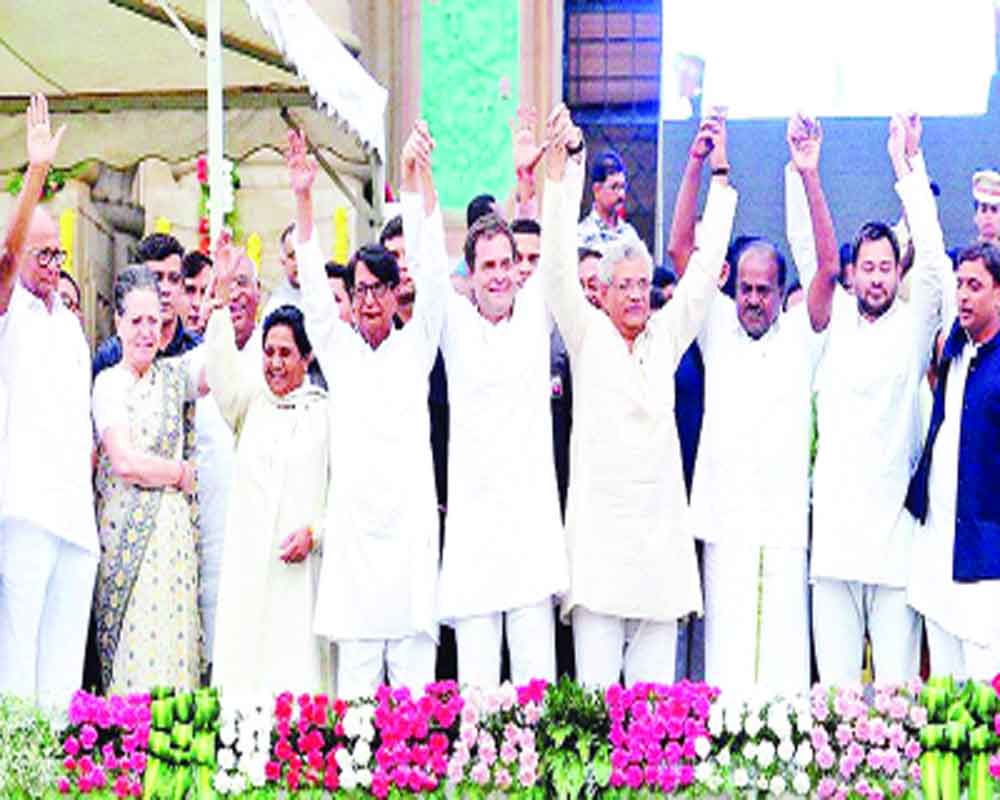Undaunted by exit polls, Opposition unity efforts have gained momentum this past week. Almost all players have at some point in time dreamt of the prime ministerial job but the road to it is strewn with many hurdles and their contradictions
Most exit polls have predicted a clear majority for the ruling Bharatiya Janata Party (BJP) but this hasn’t stopped the Opposition from going ahead with its plans of forming a non-BJP coalition to stake claim to power. Opposition leaders, including West Bengal Chief Minister Mamata Banerjee, have pooh-poohed the exit poll predictions, claiming they were all wrong. Congress leaders in private have rubbished them pointing out that the pollsters had gone wrong in 2004. It is this hope that is keeping the unity move going forward.
Opposition parties are preparing for a 1996 (United Front) or 2004 (UPA) post-poll scenario, expecting a hung Parliament. The Opposition unity efforts gained momentum this past week and is continuing to gather strength even after the exit polls.
Can the anti-BJP front become a reality? Most major Opposition parties are coming together as they don’t want to be caught napping if the BJP fails to get a majority. UPA chairperson Sonia Gandhi has convened a meeting of 21 Opposition parties on May 23, the day when the results will be announced. Sonia Gandhi, who took a back seat ever since she handed over the baton to her son Rahul Gandhi last March, has come to the forefront again because the Congress feels that senior Opposition leaders like former Prime Minister HD Deve Gowda, Nationalist Congress Party chief Sharad Pawar, Mamata Banerjee, Loktantrik Janata Dal (LJD) chief Sharad Yadav and others will have no hesitation to work under her. During the campaign, Sonia Gandhi had herself reminded people about the 2004 surprise victory of the UPA in spite of the “India shining campaign” of the BJP.
The main anchor for the unity move is Andhra Pradesh Chief Minister N Chandrababu Naidu. Fearing a total rout in his State, Naidu has been busy looking for a national role. He has been visiting Rahul Gandhi, Mamata Banerjee, Samajwadi Party chief Akhilesh Yadav, Sharad Yadav, Sharad Pawar, Bahujan Samaj Party supremo Mayawati and others, holding intensive talks with them about staking claim with the President in case the BJP did not get the majority. Insiders say that they want to try the Karnataka model where the Congress prevented the BJP from forming the Government by supporting a junior party Janata Dal (Secular) though the BJP had emerged the single largest party. It is this ‘keep BJP out’ move which is binding the Opposition. But for all these, the results have to show a hung Parliament with the BJP getting less than 200 seats. Only then can the Opposition get a chance.
Let us once assume that there is a possibility of a situation as created in 1996 or 2004. In 1996, the Congress supported the United Front Government. The constituents chose Deve Gowda as Prime Minister though he was the fourth choice after VP Singh, Jyoti Basu and GK Moopanar. Even at that time, it was not easy for the rag-tag coalition to decide as there were many aspirants. In 2004, the UPA won the race.
Naidu wants to cobble together a coalition of regional parties and take help of the Congress to form a Government at the Centre. Though the Congress may be the single largest Opposition party, Naidu expects it to play second fiddle and reserve the Prime Minister’s post for a regional leader. There are too many aspirants for the post among the regional satraps. The Congress is the only party other than the BJP that is likely to cross the 100 mark and it would surely demand the top post for Rahul Gandhi. Pre-poll allies like Dravida Munnetra Kazhagam chief MK Stalin, Deve Gowda and Rashtriya Janata Dal leader Tejashwi Prasad Yadav have supported Rahul Gandhi’s claim. Mamata Banerjee, too, is a front-runner for the post. Mayawati has not hidden her ambitions of becoming the Prime Minister since many years. Telangana Chief Minister K Chandrashekhar Rao believes that with his 16 seats, he can become the kingmaker. Odisha Chief Minister Naveen Patnaik, too, is demanding the price of a special status for his State. Sharad Pawar is the seniormost leader, who has good relations with all players and had been nursing prime ministerial ambition for decades. How do you reconcile these interests for a single position, which is not vacant yet?
It is not going to be easy for the non-BJP parties to stake claim. They have to cross many hurdles, including choosing their prime ministerial face, a Common Minimum Programme and dealing with inherent contradictions in such a coalition among other things. Past record shows that there have been five non-Congress, non-BJP Governments so far and none of them lasted a full term. Four of them had the support of the Congress while the BJP supported the fifth one.
After May 23, if the NDA forms the Government, the Opposition should play a constructive role as a collective entity if they don’t achieve their dream. They must remember that by staying divided, they helped Prime Minister Modi get a second term. Had they been united before the elections, they might have defeated the BJP.
(The writer is a senior political commentator and syndicated columnist)


























